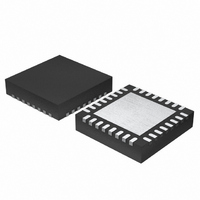EL7640AILTZ Intersil, EL7640AILTZ Datasheet - Page 17

EL7640AILTZ
Manufacturer Part Number
EL7640AILTZ
Description
IC CONV DC/DC TFT-LCD 32-QFN
Manufacturer
Intersil
Datasheet
1.EL7642AILTZ-T7.pdf
(19 pages)
Specifications of EL7640AILTZ
Applications
Converter, TFT, LCD
Voltage - Input
2.6 ~ 5.5 V
Number Of Outputs
3
Voltage - Output
5.5 ~ 20 V
Operating Temperature
-40°C ~ 85°C
Mounting Type
Surface Mount
Package / Case
32-WQFN, 32-miniQFN
Lead Free Status / RoHS Status
Lead free / RoHS Compliant
supplies. A high quality layout/design of the PCB, in respect
of grounding quality and decoupling is necessary to avoid
falsely triggering the fault detection scheme – especially
during start-up. The user is directed to the layout guidelines
and component selection sections to avoid problems during
initial evaluation and prototype PCB generation.
V
The V
switching the voltage on COM between ground, DRN and
SRC, under control of the start-up sequence and the CTL pin.
During the start-up sequence, COM is held at ground via an
NDMOS FET, with ~1k impedance. Once the start-up
sequence has completed, CTL is enabled and acts as a
multiplexer control such that if CTL is low, COM connects to
DRN through a 5Ω internal MOSFET, and if CTL is high,
COM connects to SRC via a 30Ω MOSFET.
The slew rate of start-up of the switch control circuit is mainly
restricted by the load capacitance at COM pin as in the
following equation:
Where V
circuit, R
including the internal MOSFET r
and the resistor inserted, R
switch control circuit, and C
switch control circuit.
In the Typical Application Circuit, R
bias to DRN based on the following equation:
and R
Op Amps
The EL7640A, EL7641A and EL7642A have 1, 3 and 5
amplifiers respectively. The op amps are typically used to
drive the TFT-LCD backplane (V
correction divider string. They feature rail-to-rail input and
output capability, they are unity gain stable, and have low
power consumption (typical 600µA per amplifier). The
EL7640A, EL7641A and EL7642A have a –3dB bandwidth
of 12MHz while maintaining a 10V/µs slew rate.
Short Circuit Current Limit
The EL7640A, EL7641A and EL7642A will limit the short
circuit current to ±180mA if the output is directly shorted to
the positive or the negative supply. If an output is shorted for
a long time, the junction temperature will trigger the Over
Temperature Protection limit and hence the part will shut
down.
∆V
------- -
V
∆t
DRN
ON
=
-Slice Circuit
ON
10
----------------------------------- -
(
=
R
i
i
-slice Circuit functions as a three way multiplexer,
g
V
------------------------------------------------------------ -
can be adjusted to adjust the slew rate.
||
is the resistance between COM and DRN or SRC
ON
is the supply voltage applied to the switch control
R
V
L
g
) C
•
•
R
R
9
8
L
+
+
A
R
VDD
9
•
R
L
L
8
17
is the load resistance of the
is the load capacitance of the
DS(ON)
COM
8
, R
) or the gamma-
9
, the trace resistance
and C
EL7640A, EL7641A, EL7642A
8
give the
Driving Capacitive Loads
EL7640A, EL7641A and EL7642A can drive a wide range of
capacitive loads. As load capacitance increases, however,
the –3dB bandwidth of the device will decrease and the
peaking will increase. The amplifiers drive 10pF loads in
parallel with 10kΩ with just 1.5dB of peaking, and 100pF
with 6.4dB of peaking. If less peaking is desired in these
applications, a small series resistor (usually between 5Ω and
50Ω) can be placed in series with the output. However, this
will obviously reduce the gain. Another method of reducing
peaking is to add a “snubber” circuit at the output. A snubber
is a shunt load consisting of a resistor in series with a
capacitor. Values of 150Ω and 10nF are typical. The
advantage of a snubber is that it does not draw any DC load
current and reduce the gain.
Over-Temperature Protection
An internal temperature sensor continuously monitors the
die temperature. In the event that the die temperature
exceeds the thermal trip point, the device will be latched off
until either the input supply voltage or enable is cycled.
Layout Recommendation
The device’s performance including efficiency, output noise,
transient response and control loop stability is dramatically
affected by the PCB layout. PCB layout is critical, especially
at high switching frequency.
There are some general guidelines for layout:
1. Place the external power components (the input
2. Place V
3. Reduce the loop with large AC amplitudes and fast slew
4. The feedback network should sense the output voltage
5. The power ground (PGND) and signal ground (SGND)
6. The exposed die plate, on the underneath of the
7. To minimize the thermal resistance of the package when
capacitors, output capacitors, boost inductor and output
diodes, etc.) in close proximity to the device. Traces to
these components should be kept as short and wide as
possible to minimize parasitic inductance and resistance.
rate.
directly from the point of load, and be as far away from LX
node as possible.
pins should be connected at only one point.
package, should be soldered to an equivalent area of
metal on the PCB. This contact area should have multiple
via connections to the back of the PCB as well as
connections to intermediate PCB layers, if available, to
maximize thermal dissipation away from the IC.
soldered to a multi-layer PCB, the amount of copper track
and ground plane area connected to the exposed die
plate should be maximized and spread out as far as
possible from the IC. The bottom and top PCB areas
especially should be maximized to allow thermal
dissipation to the surrounding air.
REF
and V
DD
bypass capacitors close to the pins.
May 15, 2006
FN6270.0











